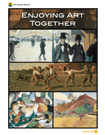Charlotte Mason methodology is a strong component of all of My Father’s World’s curriculum, but it is especially evident in their Enjoying Art Together set. Enjoying Art Together is included in MFW’s deluxe First Grade Curriculum, but it can be purchased separately. It could easily be used with children in any of the elementary grades.
The set includes a brief teacher’s guide and a set of twenty 8.5 x 11 inch art prints. The first ten prints include an animal (usually within a larger scene that might include people) and the last ten focus on people. Prints are from 19 different artists and present a variety of artistic styles. Some of the prints such as the “Mona Lisa” are very well known and others less so. They might be used in any order.
In line with Charlotte Mason’s ideas, the guide suggests that you use one print at a time, posting it somewhere prominent or having the child hold the print in his or her hands so he or she can really study it. There is nothing to memorize at this stage. Instead, the parent is supposed to simply encourage discussion and observation of the print. On the back of each print you will find some basic information about the print that you might share with your child if it seems appropriate. Sometimes there might be a suggestion such as, “Let’s find the far away island of Tahiti on a globe” on the back of Paul Gauguin’s “Tahitian Landscape.” There are also some “leading questions” you might use to engage your child in a discussion, questions like, “What are the people doing in this picture?” and “Do the dogs look like they are excited or tired?” This same information is included in the teacher’s guide along with a small color image of the print. The questions make it easier for parents who haven’t a clue how to begin a discussion regarding a work of art. The guide also has some general suggestions for other activities such as hands-on projects, and storytelling that you might use in relation to any of the prints.
The art prints are reproduced on heavy card stock at fairly high resolution. This means the cards should stand up to handling by children although you might want to keep them in page protectors to protect the surfaces. It also means that details of the paintings such as brush strokes to portray hair are fairly visible. While this isn’t the same as being able to see the texture and three-dimensional reality of paint on canvas, viewers can still make out many fine details.
I especially like this particular selection of art prints since I think they will be fairly interesting to children and will provide a broad exposure to artists and styles.









